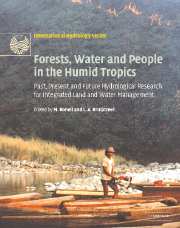 Forests, Water and People in the Humid Tropics
Forests, Water and People in the Humid Tropics Book contents
- Frontmatter
- Contents
- List of contributors
- Foreword
- Preface
- Acknowledgements
- Symposium and Workshop
- Introduction
- Part I Current trends and perspectives on people–land use–water issues
- Part II Hydrological processes in undisturbed forests
- Part III Forest disturbance, conversion and recovery
- Part IV New methods for evaluating effects of land-use change
- Part V Critical appraisals of best management practices
- Conclusion: Forests, water and people in the humid tropics: an emerging view
- Plate section
- References
Conclusion: Forests, water and people in the humid tropics: an emerging view
Published online by Cambridge University Press: 12 January 2010
- Frontmatter
- Contents
- List of contributors
- Foreword
- Preface
- Acknowledgements
- Symposium and Workshop
- Introduction
- Part I Current trends and perspectives on people–land use–water issues
- Part II Hydrological processes in undisturbed forests
- Part III Forest disturbance, conversion and recovery
- Part IV New methods for evaluating effects of land-use change
- Part V Critical appraisals of best management practices
- Conclusion: Forests, water and people in the humid tropics: an emerging view
- Plate section
- References
Summary
INTRODUCTION
Tropical forest loss: extent, patterns and causes
Land use patterns in most humid temperate countries have more or less stabilised over the past century. Changes are still taking place (e.g. urbanisation in some areas, abandonment of agricultural cropping in favour of natural regeneration in others) but they are generally rather gradual. This is not the case in most humid tropical countries where significant land use changes are still under way and often take place at an unprecedented rate. Most of these relate to changes from the original forest cover to either heavily modified (degraded) forest or non-forest land use, such as (slash and burn) agriculture, grazing or plantations of various types.
The spatial extent and trends of land cover change in the tropics have been the subject of much debate, mainly because of the different definitions for various vegetation cover types used by the respective surveys. Although it has proven difficult to obtain accurate and verifiable figures, the successive Forest Resources Assessments (FRA) of the United Nations Food and Agriculture Organization (FAO) have produced an overall picture from which a number of conclusions can be drawn. The estimated average rates of closed tropical forest loss in the developing world are about 14.6 and 14.9 million ha year-1 for the periods 1980–1990 and 1990–2000, respectively. As such, an area of almost 300 million ha of closed tropical forest has disappeared during the last two decades (roughly equivalent to two-thirds of continental Europe excluding Russia).
- Type
- Chapter
- Information
- Forests, Water and People in the Humid TropicsPast, Present and Future Hydrological Research for Integrated Land and Water Management, pp. 906 - 925Publisher: Cambridge University PressPrint publication year: 2005
References
- 22
- Cited by


